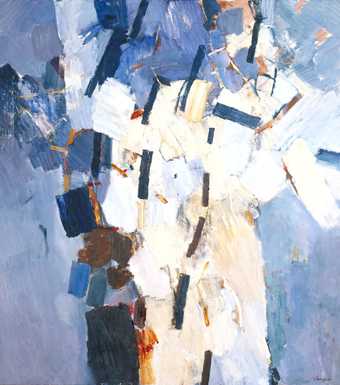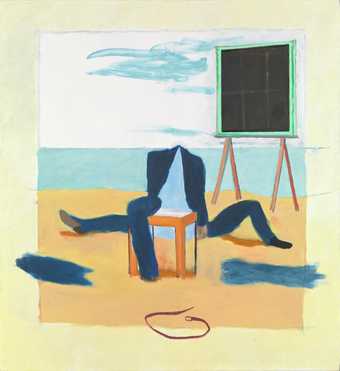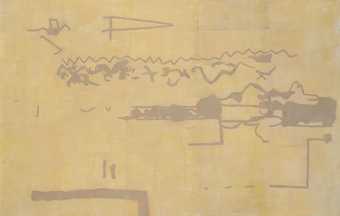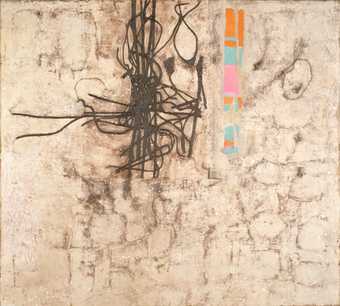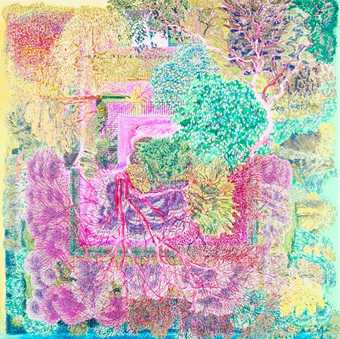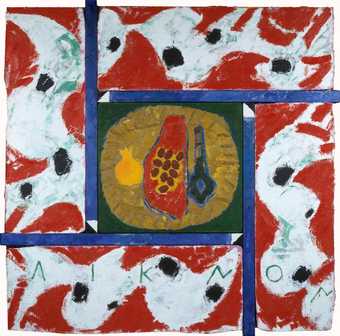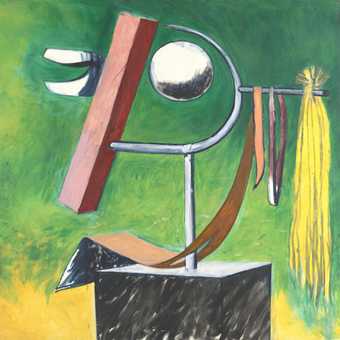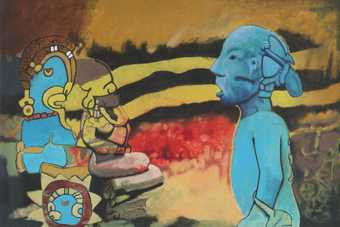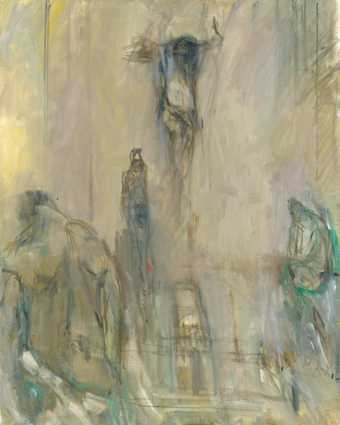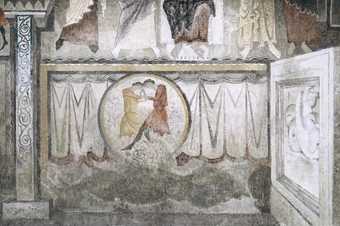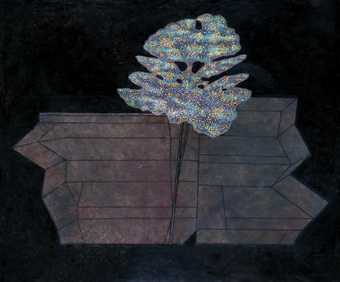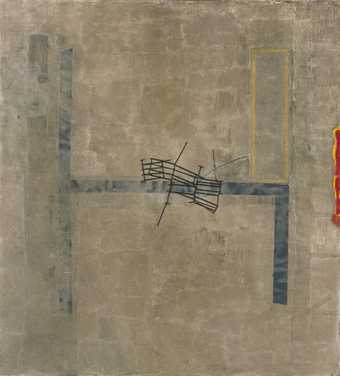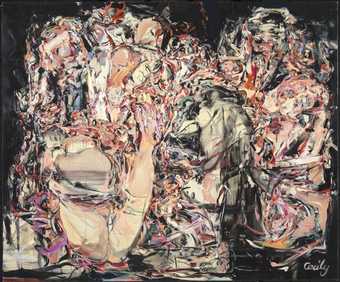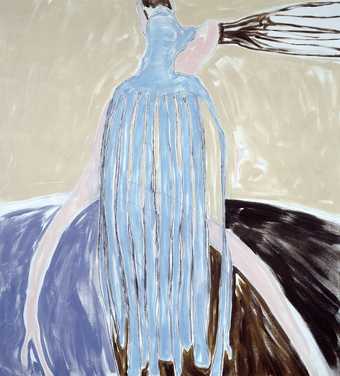
In Tate Liverpool
- Artist
- Nicola Tyson born 1960
- Medium
- Oil paint on canvas
- Dimensions
- Support: 1426 × 1273 × 39 mm
- Collection
- Tate
- Acquisition
- Purchased 1999
- Reference
- T07492
Summary
This large painting by the British artist Nicola Tyson depicts a feminine form shown upside down against a light blue background. The figure’s pink head appears in the bottom of the canvas and its arms are outstretched either side of its black body, creating the impression that it is floating. The proportions of the body are distorted: the head is bulbous and too large for the otherwise slim and elegant torso, legs and arms. These, too, do not appear naturalistic: the figure’s legs taper into a single point near the top of the canvas and its arms are plant-like and seem to wave fluidly. The blue background is flat, but also mottled as if it presents an area of water as seen from above on which a faint sunlight is shining. Although seemingly calm and directionless in its movements, the black form contrasts deeply with its paler background and it stretches the full height of the canvas, appearing confined by the painting’s upper and lower edges.
Swimmer was made in 1995 in New York, the city to which Tyson moved from London in 1990. To make the work, Tyson began by priming the canvas with a white ground onto which the outline of the figure was then laid down in charcoal lines that are still visible at the figure’s edges. Although the paint has been applied to the canvas thinly, with no impasto, the broad brushmarks making up the background contrast with the even application and glossier finish of the paint used for the figure, giving variety to the canvas’s surface. For the swimmer’s body, Tyson has created highlights using grey paint and by abrading the darker pigment in places to reveal the white priming underneath.
The work’s title suggests that the figure can be seen in the context of swimming and bathing, with the shape either moving through or floating in water. Yet it remains unclear whether the subject is male or female, or human or animal, an ambiguity that is enhanced by the form’s inverted position and the lack of reference points in the scene’s featureless background. Despite this, as Vincent Katz noted in a review of the artist’s work in 1998, ‘although Tyson takes great liberties with anatomical definition, limbs and heads have an uncanny realism in their gestures and even their shapes’ (Katz 1998, p.98). In this way, Tyson’s forms tend to outline or indicate rather than describe, as can be seen in this work and in the later Curtain Figure 1999 (Tate T12599).
Although ambiguous, this figure’s shape hints at femininity: it has a petite, hourglass-like form, which tapers in at the waist and then out again into curvaceous hips. The soft, flowing outlines of its body add to this sense of femininity, yet the figure’s bulbous head is more androgynous and counterbalances the slightness of the rest of the form. Many of Tyson’s works of the 1990s contain androgynous figures that she has manipulated beyond gender identification or those that hint at the feminine without stating it clearly, as is also seen in Curtain Figure, in which limbs emerge from behind a dress-like curtain of fabric and a series of brown lines protrude from the top, suggesting a woman’s head of hair. In a review of a solo exhibition of Tyson’s work held at the Friedrich Petzel Gallery, New York, in 1995, the art critic Keith Seward observed that ‘perhaps the obdurate individuality of these figures, defined not by particularised faces, as in traditional portraiture, but by singular combinations of vegetal torsos, insectoid legs and monstrous genitalia, reflects a deliberate attempt to unleash the power of the freakish – to go beyond genders, classes, categories’ (Seward 1995, p.107). As well as Tyson’s tendency to distort the identity of her subjects, reviews of her exhibitions in the mid- to late 1990s also foreground their sensuality, making reference to the ‘vulva-like spirit’ of her figures (Saltz 1994, p.118), an observation that could be applied to the organic, fleshy form seen in Swimmer.
Swimmer was exhibited as part of Tyson’s first solo exhibition, held at the Anthony d’Offay Gallery in London in 1995.
Further reading
Jerry Saltz, ‘Nicola Tyson at Trial Balloon’, Art in America, May 1994, pp.118–19.
Keith Seward, ‘Nicola Tyson. Friedrich Petzel Gallery’, Artforum, Summer 1995, pp.106–7.
Vincent Katz, ‘Nicola Tyson at Friedrich Petzel’, Art in America, January 1998, pp.98–9.
Louise Hughes
March 2015
Supported by Christie’s.
Does this text contain inaccurate information or language that you feel we should improve or change? We would like to hear from you.
Display caption
Gallery label, August 2004
Does this text contain inaccurate information or language that you feel we should improve or change? We would like to hear from you.
Technique and condition
The painting is on a single piece of coarse, plain weave linen canvas. This is stretched over and stapled to the reverse of a 6 member expandable softwood with the two cross members half lapped where they cross each other. Triangular section beading at the outer edges of the stretcher, keeps the canvas away from the stretcher bars. Stamps on the reverse indicate that the stretcher was made in the USA by TRI-MAR Enterprises Inc. USA.
There is a size layer visible on the unpainted turnover edges of the canvas at the sides but not extending onto the canvas folded over and attached to the reverse of the stretcher. It has distinctive glittery appearance in strong light and it fluoresces in ultra violet light indicating that it may be an animal glue. It is a fairly substantial layer, evenly filling the interstices of the weave and adding a substantial amount of stiffness to the linen where it is present. The size was apparently applied after the canvas had been stapled onto this stretcher and there is no evidence of restretching
A white priming layer is just visible at the edges of the painted area. Neither pigment or media have been analysed, and as almost all of it is covered by paint layers it is not possible to describe the consistency. It appears to cover the whole of the front of the canvas and has been applied carefully so as not to extend over the tacking edges. The layer is sufficiently thin to allow the texture of the coarse weave linen to remain prominent. None of the priming has penetrated through to the back of the canvas.
The paint appears to be oil, but no analysis has been carried out to confirm this or to identify the pigments used. The paint is well bound and generally paste in consistency. It has been brushed in thin layers over the whole of the face of the canvas. The tacking edges have been left intentionally unpainted, particularly at the more visible left and right edges, but there are some drips and smears of paint extending around on to the tacking edges particularly at the top edge.
Some traces of a black charcoal or similar drawing material are visible at the edges of the form. The outlines seem to have been established at an early stage, and little changed during the painting process. The paint is quite thinly applied with no impasto, but broad brush marks of slightly different direction, thickness and gloss give a subtle variety to the surface in the pale green background. Darker underlayers show through the pale green background and the flesh colour of the swimmer's head, giving a slightly uneven, scumbled appearance to the otherwise flat colour in these areas. The dark paint of the swimmer has a more even finish and higher gloss. A suggestion of form has been produced by softly painted mid grey highlights over the dark grey/black paint of the figure's body used in conjunction with abrasion of the dark grey/black to reveal the pale priming at the tops of the canvas weave.
The painting is not varnished and has no frame
The condition of the work is very good. The canvas is substantial and tautly stretched on a robust stretcher and the paint is thinly applied with no damages apart from very minor abrasion of paint at the corners and edges.
Sam Hodge
January 1999
Explore
- abstraction(8,615)
-
- from recognisable sources(3,634)
-
- figure(2,270)
- recreational activities(2,836)
-
- bathing / swimming(220)
You might like
-
Keith Vaughan Bather: August 4th 1961
1961 -
Victor Willing Rien
1980 -
Prunella Clough Yellow Mesh
1981 -
Prunella Clough Wire and Demolition
1982 -
Adrian Berg Gloucester Gate, Regent’s Park, May
1982 -
Joe Tilson Liknon 3
1987 -
Norman Adams Christ’s Cross and Adam’s Tree
1989 -
Victor Willing Callot: Fusilier
1983 -
Aubrey Williams Olmec Maya - Now and Coming Time
1985 -
Robert Medley A Crucifixion
1992–3 -
Valerie Thornton Bominaco (The Abruzzi)
1988 -
Prunella Clough False Flower
1993 -
Prunella Clough Broken Gates
1982 -
Cecily Brown Trouble in Paradise
1999 -
Nicola Tyson Curtain Figure
1999

